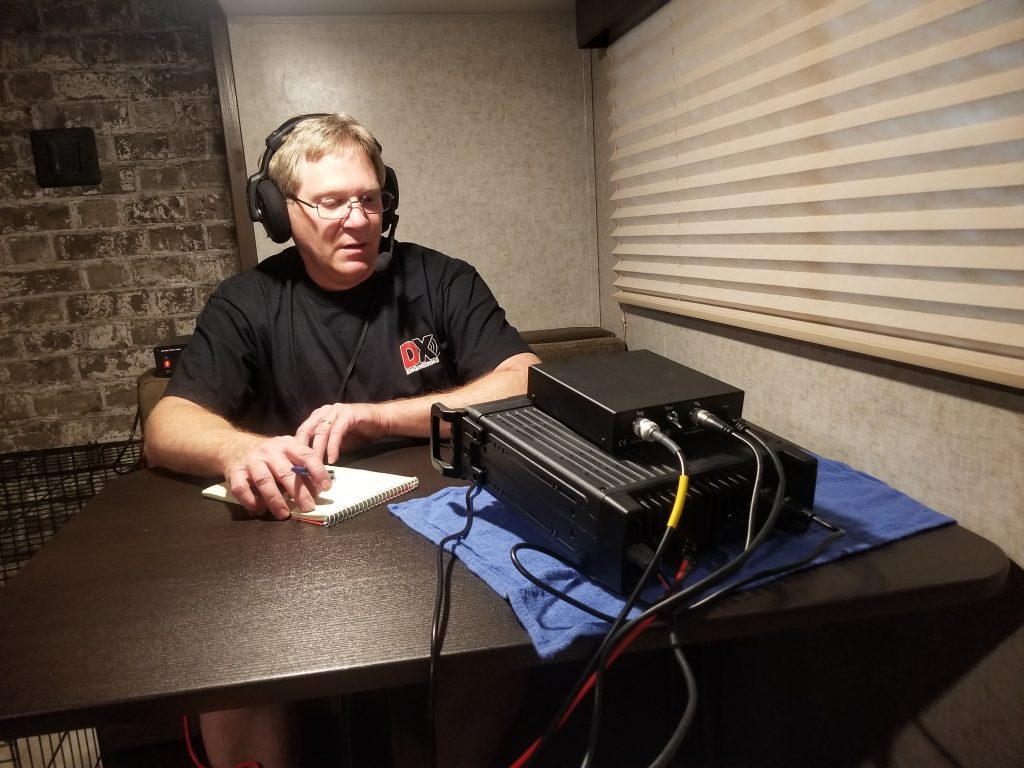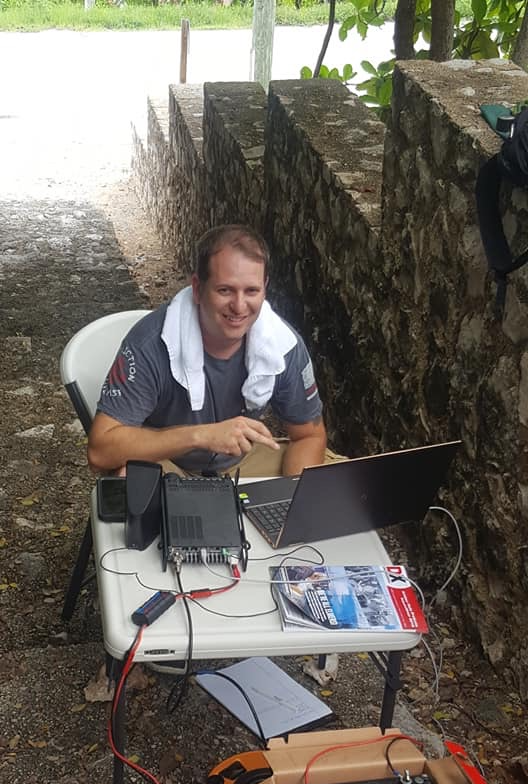Operating from a rare (or semi-rare) location is one of the greatest experiences in Ham radio. Many operators have spent time trying to work a DXpedition and have also dreamed of being part of a DXpedition team. But there are many different opportunities to be “the rare one” across the bands. You may be in a rare state during a contest, a rare grid square when operating satellites or on the VHF bands like 6 or 2 meters, or operating from a rare unit for one of many “on-the-air” programs, such as Summits on the Air, US Islands, and Parks on the Air. Many an operator has been overwhelmed by a pileup, including yours truly! I was left shell-shocked when trying to run Japanese stations on CW during my first trip to the Caribbean country of Antigua (V2) in 1997. It can be a humbling experience.
As with any other pursuit, practice makes perfect. Getting some experience with running stations quickly and efficiently in a pileup situation will boost your confidence. It will probably make you want to do it more, as well! Many skilled operators relish a pileup as a form of meditation. I agree with this sentiment. When you’re in a pileup and everything is working well and running smoothly, it is one of the greatest examples of being completely in the moment, with no knowledge of the outside world or the passing of time. It is a perfect state of being.
Here are a few tips on running a pileup that will develop into solid operating skills for years of enjoyment in Ham radio, no matter what band or mode, whether operating in a contest, on a DXpedition, or as part of a weekend special event station.
Don’t Bite Off More Than You Can Chew
If you have never operated from The Other Side of the Pileup, waiting until you’re on that sunny island with your wire in the trees is not a good idea. If you know you’re going on a trip with radio involved, do whatever you can to get on the air and get some practice in pileup management. Are there any contests or QSO parties coming up you can participate in? If yes, get involved as much as you can. Focus on calling CQ and working stations, not spinning the dial and answering other CQs. Get used to hearing more than one station calling you at once.

Be Brief and Develop a Consistent Pattern
In the interest of being polite, you may feel the need to spend some time having a short QSO with everybody you work. However, if you are in a pileup situation, you have several (or more) people waiting their turn to talk to you. Propagation may shift, your operating time may be limited, and so may theirs. A pileup is not the time to engage in small talk. Get their call correct, exchange the required info (such as park number or grid square), and acknowledge the contact is over. Do this the exact same way for every contact you make. This develops a recognizable pattern that the pileup participants can decode. Here’s an example of consistent delivery:
Me: “CQ Parks on The Air, Kilo X-Ray Nine X-Ray”
Pileup: I hear “Whiskey One Papa Yankee”
Me: “Whiskey One Papa Yankee, 5-9 K-4097”
W1PY: “Thanks, 5-9 Massachusetts”
Me: “73, Q-R-Z?”
Pileup: I hear “Kilo Four Romeo Oscar”
Me: “Kilo Four Romeo Oscar, 5-9 K-4097”
K4RO: “QSL, 5-9 Tennessee”
Me: “73, Q-R-Z?”
Pileup: I hear “Zero Alpha”
Me: “Who’s the ‘Zero Alpha’?”
Pileup: “November Zero Alpha X-Ray”
Me: November Zero Alpha X-Ray, 5-9 K-4097”
N0AX: “Roger, 5-9 Missouri”
Me: 73, Kilo X-Ray Nine X-Ray, Q-R-Z?
This approach makes handling the pileup almost formulaic. During pileup calls, I identify a station as best as possible and give the info. Then the station I acknowledge replies with their info. I correct the call (if needed) and acknowledge their report before saying “73, Q-R-Z,” which is the sign that I am done working the station and am listening for the next station to call me. Using this method, the pileup has a rhythm to it, and all participants know when one contact is over and when to call me again. It’s efficient and orderly. A contact using this method shouldn’t take more than 15-20 seconds, which gives the pileup an understanding that they won’t have to wait too long to try and call me again.
Use Phonetics. ALWAYS.
Using phonetics in a pileup situation helps eliminate guesswork on everybody’s part. Reducing guesswork or the need to ask for a clarification improves efficiency, which reduces the length of time a contact takes. This ultimately keeps the pileup moving along.
Work Loud Stations First
This may seem like a no-brainer, but it bears repeating. Loud stations are easy to work; they also inhibit your ability to hear weaker stations. Work the loud ones quickly and get them out of the way so you can focus on working everybody.
Understand Propagation
As you are working the pileup, have an awareness of where stations are calling you from. For example, are you hearing lots of stations from the Southeastern U.S.? There may be stations from other areas trying to contact you, but you can’t hear them through all the Southeastern stations. On occasion, take a minute to ask for callers from other parts of the country (or world, if appropriate). Understand which band will be open to a part of the country (or world) you want to work. Make sure you give as many people the opportunity to make a contact with you as time and band conditions allow.
Listen for One Letter
If the pileup is big enough, you may have difficulty discerning a complete call in the noise. If that’s the case, pick out one or two letters in a signal. “Who’s the station with Oscar?” will filter out a large portion of the pileup and allow you to better hear who that is with Oscar in their callsign. Do this as often as needed.

Ignore QRMers
There will be times when somebody will try to disrupt your pileup. Those people are jerks. To the best of your ability, simply ignore them. Acknowledging them in any way will tell them their disruption is working. Continuing to work people through noise is the best way to tell them their tactics aren’t working. If the problem is so severe you can’t work anybody, take a break or move to a different frequency.
Use Your RF Gain
If you have a situation where you have a lot of callers that are weak and/or right at the noise level and it is causing you trouble copying louder signals, consider lowering your RF gain to eliminate the weaker signals from your receiver. Yes, you should try to work as many as possible, so consider this as a last-ditch effort to reduce the noise in a pileup.
Going “By the Numbers”
If a pileup is particularly rough, you can start calling stations with a specific number in their call. Example: “KX9X, Q-R-Z ones only.” This is known as going “by the numbers.” It should only be used if the pileup is particularly large and you are having significant trouble hearing stations.
While it is seemingly logical to start at the number 1 and sequentially work your way to 0, caution should be taken with this approach. Depending on propagation, it may be more advantageous to start with a number that you are hearing lots of, or consider working from one coast to another if you’re having trouble hearing stations from that area. It is common for stations in the Midwest to have good propagation to the Southeast or New England; you can ask “Are there any W6/W7 stations on?” as a direct request for stations on the West Coast.
Regardless of what order you work the numbers, do not dwell on a single call area for too long; you run the risk of propagation fading to an area and upsetting the stations in that area. A good rule of thumb is to work no more than five stations from a particular call area before moving on to another. Keep your rate up. Again, it’s all about giving your pileup audience an expectation of when they can call you and how the rhythm of the pileup is moving.
Working Split
If the pileup is really intense, you can consider working “split” by transmitting on one frequency and listening for stations calling you on another frequency. This should only be done if the pileup is exceptionally large and running the risk of being unruly. An example is transmitting on 14.245 MHz and listening on 14.250 MHz. This frees your transmit frequency of many stations calling you, making it easier for the pileup to hear your signal instead of the callers. You need a radio with two VFOs to operate split (most radios today have two VFOs) and need to announce regularly to the pileup where you are listening, such as “KX9X, listening up 5, Q-R-Z.” After a QSO, you can be even more succinct: “73, Q-R-Z up 5.” Splits between transmit and receive frequencies shouldn’t be that great: 5-10 kHz for SSB, 1-2 kHz for CW. Again, operating split should only be done in very tough pileup circumstances. This technique is generally only used by stations operating on a DXpedition or from a particularly rare DXCC entity. Working split takes practice and should not be attempted unless you know what you’re doing.
Stay Calm and have Fun
Ultimately, working a pileup is about having fun. If it gets to be too intense or it feels like a job, take a break and go do something else for a while. Sometimes clearing your head can be the best thing for your concentration.
Pileups mean you’re the sought-after station and everybody wants a contact with you! But it’s easy to view pileups as a headache rather than a good time. Learning how to properly manage a pileup will make it more enjoyable for everybody. Try these techniques the next time you go out on a Ham radio trip for your favorite activity and see if you have more fun on The Other Side of the Pileup.

